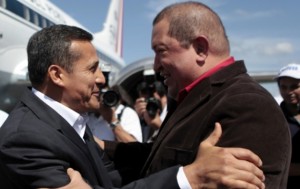By Ariela Ruiz Caro
After President Ollanta Humala’s state visit to Venezuela Jan 7, and despite some adverse reactions to the visit in Peru, Humala announced that the two countries have “succeeded in turning away from the bilateral politics of the past in which nothing major had been accomplished in diplomatic, commercial and cultural relations.”
In effect, the two presidents reached new agreements in the areas of trade, energy, education, social programs and economy, as well as migratory regulation.
A top priority of the visit was to maintain, insofar as possible, the Commercial Liberation Program negotiated within the Andean Community (CAN). Venezuela withdrew from CAN on April 22, 2006, claiming that Colombia and Peru’s free trade agreements with the United States, “created a new legal body that tried to assimilate the regulations of free trade into the Andean Community, changing de facto its nature and original principles.” The Foreign Minister at the time, Alí Rodriguez, who is in line to become the next Secretary General of Unasur, sent a letter to CAN members in which he denounced the Cartagena Agreement, and consequently announced the withdrawal of Venezuela from CAN. Nonetheless, Venezuela remained within the Commercial Liberation Program for five years following its decision to withdraw from the CAN, which now consists only of Peru, Colombia, Bolivia and Ecuador.
After leaving the Andean organization, Venezuela solicited admission as a full member of Mercosur (a trade association of Brazil, Argentina, Uruguay and Paraguay). Currently, Venezuela only needs the approval of Paraguay’s congress to join Mercosur, which gave the country the status of “state-in-process” at December’s Presidential Summit of Mercosur in Montevideo. At the same summit, the Ecuadorian government also solicited its incorporation as a full member of Mercosur.
The CAN’s Andean Commercial Liberation Program has been delayed three times since April 2011, and a partial, complementary commercial accord is still in the works with another trade group- the Latin American Integration Association (ALADI). As opposed to a typical free trade agreement, the program only includes aspects related to the sale of goods.
During President Humala’s visit, the leaders signed a “framework agreement” in which both countries agree to liberalize trade in exportable goods. Using this as a starting point, they will continue negotiating other aspects of the agreement, including rules of origin, health requirements, and others. As opposed to the CAN’s “Free Trade Zone” that eliminates the whole structure of customs, the agreement will apply to a limited number of goods.
Ninety-six percent of Peruvian goods exported to Venezuela are non-traditional products, mostly textile, chemical and mechanical/metal sectors. In spite of problems that Venezuela’s currency can cause some Peruvian exporters, this deal is important to and will empower this market.
The agreements reached in the energy sector, especially the agreement between the national oil companies, have caused an outcry from some important political sectors and businesses that have labeled them “extremely dangerous” for the country and “a perverse vehicle for installing Venezuelan methods in Peru.”
The memorandum of understanding between the state-run oil companies Petróleos de Venezuela (PDVSA) and PetroPeru seeks only to establish means of cooperation on issues of mutual economic interests in hydrocarbons, including exploration, mining, transport, storage, refining and commercialization, as well as in oil services, petrochemicals and training in hydrocarbons.
An executive committee will be named to comply with these objectives. The committee is charged with seeking approval from public entities and corresponding governments and with bringing them to the practice by means of subscribing to specific accords that will be directly formalized or formalized through their subsidiaries or branches. A timeline has been established for envoys from Venezuela to visit Peru in mid-January. Peruvian envoys will reciprocate the visit the following week, which the media is utilizing to generate a fear campaign.
The two countries haven’t only left behind multilateral negotiations for trade issues. The relationship between Venezuela and the Andean countries in the energy sector also has been “bilateralized”. The CAN took up the Petro-Andean Energy Initiative during the XVI Andean Presidential Summit in July 2005 in Lima. This was presented as a common platform or strategic alliance of the state oil and energy companies of the five CAN countries. The objective was to increase electric and gas interconnection in the region, the mutual provision of energy resources, and joint investment in electrical projects.
At that Presidential Summit, leaders of the Andean countries created the “Presidential Act of Lima: Democracy, Development and Social Cohesion”, which explores the benefits of formulating a shared Andean agenda on energy in the context of South American integration. It took into account existing bi-national accords and the energy potential represented by the area’s supply of petroleum deposits, coal and gas reserves, water, solar, wind and other alternative energy sources.
At the same time, the CAN’s Council of Ministers on Electricity, Hydrocarbons, and Mines recognized how the impacts of international oil price volatility underline the importance of structuring a strategic alliance to strengthen the stability and development of their countries.
However, the Venezuela-proposed Petroandina coalition never panned out. Shortly after the failure of Petroandina, Venezuela left the CAN, but Venezuela agreed to bilateral energy cooperation with former Andean associates Bolivia and Ecuador. And in November of 2005, Colombia and Venezuela signed the Declaration of Punto Fijo, which led to the construction of the Colombian—Venezuelan gas pipeline, opened in 2007.
With the recent agreement, Peru becomes the last Andean country to explore energy cooperation with the most important energy power in the region.
Ariela Ruiz Caro is an economist who currently works as an international consultant on trade, integration, and natural resources at the Economic Commission for Latin America and the Caribbean (CEPAL), the Economic System of Latin America (SELA) and the Institute for the Integration of Latin America and the Caribbean (INTAL), among others. She worked for the Andean Community (CAN) from 1985 to 1994 and as an assessor for Mercosur’s Commission of Permanent Representatives between 2006 and 2008. She collaborates as a columnist with the Americas Program.




